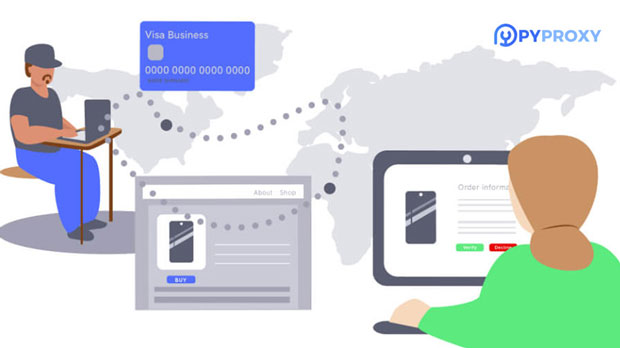PYPROXY and FoxyProxy are widely used tools for managing proxy configurations. Both offer support for various proxy protocols that help users maintain privacy and manage internet traffic efficiently. PyProxy supports protocols such as HTTP, HTTPS, SOCKS4, and SOCKS5, providing flexibility for different use cases. On the other hand, FoxyProxy primarily focuses on protocols like HTTP and SOCKS, offering an easy-to-use interface for managing proxy settings across different browsers. Understanding which proxy protocols are supported by each tool is crucial for users who need specific functionalities for secure browsing or circumventing geo-blocked content. Understanding Proxy Protocols and Their ImportanceProxy protocols are essential for controlling internet traffic, enhancing security, and ensuring anonymity while browsing. A proxy acts as an intermediary between the user and the web, routing traffic through servers to hide the user’s IP address or access restricted content. The type of protocol supported by a proxy tool determines the range of applications it can be used for. Different protocols cater to varying needs based on speed, security, and compatibility with different types of applications. In this section, we will delve deeper into the proxy protocols supported by PyProxy and FoxyProxy, comparing their strengths and weaknesses.PyProxy Supported Proxy ProtocolsPyProxy, a tool primarily designed for Python users, supports several proxy protocols that enable flexible and efficient traffic routing. Let’s break down the protocols supported by PyProxy:1. HTTP and HTTPS ProxyHTTP (Hypertext Transfer Protocol) and HTTPS (Hypertext Transfer Protocol Secure) are the most commonly used proxy protocols. They are generally used for web browsing. HTTP proxies forward client requests over the standard HTTP protocol, while HTTPS proxies encrypt the communication between the client and the server, providing an additional layer of security. These protocols are suitable for tasks that don’t require heavy encryption but benefit from content caching, bypassing restrictions, or load balancing.The main advantage of using HTTP and HTTPS proxies is their ability to handle web traffic efficiently. However, they are limited in terms of encryption and security, which makes them less suitable for highly sensitive information.2. SOCKS4 and SOCKS5SOCKS (Socket Secure) is a protocol that operates at a lower level compared to HTTP and HTTPS. SOCKS4 and SOCKS5 are versions of this protocol, with SOCKS5 being the more advanced version. Unlike HTTP and HTTPS, SOCKS proxies can handle all types of internet traffic, including web browsing, emails, FTP, and torrents, making them highly versatile.SOCKS5 improves upon SOCKS4 by adding support for authentication and enhanced security features, including the ability to route traffic over different ports. This flexibility makes SOCKS5 a popular choice for users looking for anonymity and bypassing geographic restrictions, as well as for applications requiring low latency or high-speed connections. However, setting up SOCKS5 can be more complex than HTTP/HTTPS proxies, requiring additional configuration.FoxyProxy Supported Proxy ProtocolsFoxyProxy, a popular browser extension, simplifies the process of managing proxy settings. It offers support for basic proxy protocols, particularly HTTP and SOCKS. Let’s look at the details of each protocol:1. HTTP ProxyFoxyProxy supports HTTP proxies, which are typically used for browsing the web. The HTTP protocol is ideal for most users who want to hide their IP address or circumvent geo-blocked content on websites. HTTP proxies are useful for browsing and accessing restricted content but are not ideal for high-security tasks due to the lack of encryption.FoxyProxy’s integration with browsers makes it easy for users to switch between different HTTP proxy servers, and the tool simplifies managing proxy configurations. This makes it an excellent option for casual users who need an uncomplicated way to manage their proxy settings.2. SOCKS ProxySOCKS is supported by FoxyProxy, but unlike PyProxy, FoxyProxy typically focuses on SOCKS4 or SOCKS5 protocols for enhanced functionality. SOCKS proxies are generally used for handling different types of traffic, including torrenting and other peer-to-peer activities, and they can route data through different applications.The main advantage of SOCKS proxies is their ability to bypass firewalls and restrictions while supporting a broader range of protocols compared to HTTP proxies. FoxyProxy’s simple interface allows users to quickly toggle between SOCKS proxies, enhancing anonymity and the ability to circumvent content restrictions.Key Differences Between PyProxy and FoxyProxyWhile both tools offer proxy support, they have distinct differences based on their intended use and protocol flexibility.1. Protocol VarietyPyProxy supports a broader range of protocols compared to FoxyProxy, including both SOCKS4 and SOCKS5. This gives users more flexibility for different use cases, from simple web browsing to more complex applications like torrenting or high-anonymity browsing. FoxyProxy, in contrast, primarily supports HTTP and SOCKS, making it simpler but less versatile.2. Security and AuthenticationPyProxy’s support for SOCKS5 provides an added layer of security with features like user authentication and enhanced encryption, making it more suitable for security-conscious users. FoxyProxy’s support for SOCKS is generally limited to SOCKS4, which lacks the added features and flexibility of SOCKS5, limiting its use in sensitive browsing scenarios.3. Ease of UseFoxyProxy’s ease of use makes it ideal for casual users. Its simple interface is designed for users who do not need complex configurations. It is a straightforward solution for managing proxy settings in browsers. PyProxy, while more flexible, can be more difficult to configure due to its wide range of supported protocols and advanced features, making it better suited for technical users or those who require a higher level of customization.Conclusion: Which Proxy Protocol Is Right for You?The choice between PyProxy and FoxyProxy depends on the user’s needs. PyProxy, with its support for a wide range of protocols, is ideal for users who require flexibility, security, and the ability to handle a variety of applications. It is more suitable for technical users who need to fine-tune their proxy configurations for different use cases, including high-security browsing or peer-to-peer applications.On the other hand, FoxyProxy is perfect for those who need a simple and straightforward proxy management tool, particularly for web browsing and occasional use. It supports HTTP and SOCKS protocols, providing the basic functionality needed for casual internet users, without the complexity of advanced configurations.Ultimately, both tools serve their purpose in the world of proxy management, and choosing the right one depends on the specific needs of the user.
Apr 02, 2025
![arrow]()




























































